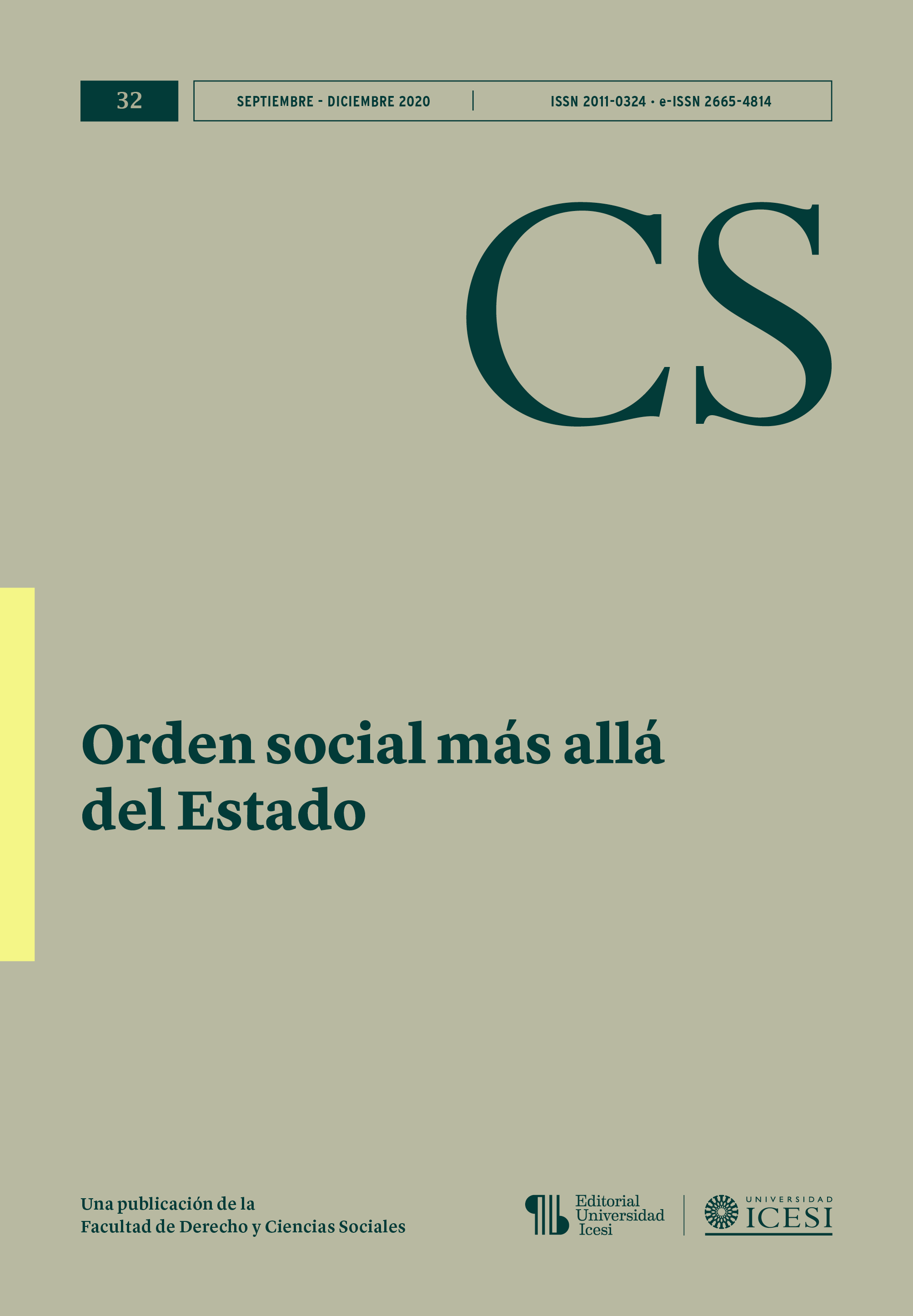State, Illegality, and Social Order from a Comparative Perspective: A Case Study Approach
DOI:
https://doi.org/10.18046/recs.i32.3987Keywords:
State, Legality, Illegality, Social OrderAbstract
This article reflects on the relationship between legality and illegality in the conformation of the social order from three problematic knots. First, the fact that most of the studies focus on regions where the centralized state and democracy have recently emerged, suggesting that in countries with more stable political systems the articulation between legality and illegality does not take place. Second, the field has been developed through case studies, however, the recurrences and construction of typologies based on prototypes of them has not been explored. Third, although the relationship between legality and illegality exists in both developed and emerging countries, this articulation may present differences between both contexts. Even though the article does not propose a definitive explanation, it does provide a hypothesis on how they could be conceptualized.
Downloads
References
Albini, Joseph; Rogers, Robert; Shabalin, Victor; Kutushev, Valery; Moiseev, Vladimir; Anderson, Julie (1995). Russian Organized Crime: Its History, Structure and Function. Journal of Contemporary Criminal Justice, 11(4), 213-243.
Beliaev, Mariov; Sheptitskii, Anna (2012). Banditskaia Kazan. Kazan: Tatpoligraf.
Bendix, Reinhard (1979). Max Weber. Buenos Aires: Amorrortu.
Bourgois, Philippe (2011). En búsqueda de respeto. Buenos Aires: Siglo XXI.
Brinks, Daniel (2006). Inequality and the Rule of Law: Ineffective Rights in Latin American Democracies. En Informal Institutions and Democracy. Lessons from Latin America (pp. 134-152), compilado por Gretchen Helmke; Steven Levitsky. Baltimore, MD: Johns Hopkins University Press.
Cloward, Richard; Ohlin, Lloyd (1963). Delinquency and Opportunity. A Theory of Delinquent Gangs. Nueva York: The Free Press.
D’Andrade, Roy (1995). The Development of Cognitive Anthropology. Cambridge: Cambridge University Press.
Dent, Nicholas (2008). Rousseau. Londres: Routledge.
Desmond-Arias, Enrique; Barnes, Nicholas (2016). Plural Orders in Rio de Janeiro, Brazil. Current Sociology, 65(3), 448-465. https://doi.org/10.1177/0011392116667165
Dewey, Matias (2012). Illegal Police Protection and the Market of Stolen Vehicles in Buenos Aires. Journal of Latin American Studies, 44(4), 679-702. https://doi.org/10.107/0022216x12000831
Dewey, Matias (2015). El orden clandestino. Política, fuerzas de seguridad y mercados ilegales en Argentina. Buenos Aires: Katz.
Durkheim, Emile (1985). La división del trabajo social. Buenos Aires: Planeta Agostini.
Ferreira, I. A. (2017). Measuring state fragility: a review of the theoretical groundings of existing approaches. Third World Quarterly, 38(6), 1291-1309.
Galeotti, Mark (ed.). (2017). Russian and Post-Soviet Organized Crime. Londres: Routledge.
Gledhill, John (2018). Securitization, Mafias and Violence in Brazil and Mexico. Global Discourse, 8(1), 139-154. https://doi.org/10.1080/23269995.2017.1406679
Grimm, S., Lemay-Hébert, N., & Nay, O. (2014). ‘Fragile States’: introducing a political concept. Third World Quarterly. 35(2), 197-209.
Gros, Jean-Germain (1996). Towards a Taxonomy of Failed States in the New World Order: Decaying Somalia, Liberia, Rwanda and Haiti. Third World Quarterly, 17(3), 455-471.
Helmke, Gretchen; Levitsky, Steven (2006). Introduction. En Informal Institutions and Democracy. Lessons from Latin America (pp. 11-25), compilado por Gretchen Helmke; Steven Levitsky. Baltimore, MD: Johns Hopkins University Press.
Holzlehner, Tobias (2014). Shadow Networks: Border Economies, Informal Markets and Organized Crime in the Russian Far East. Zúrich: Instituto Max Planck.
Kukhianidze, Alexandre (2009). Corruption and Organized Crime in Georgia Before and After the “Rose Revolution”. Central Asian Survey, 28(2), 215-234. https://doi.org/10.1080/02634930903043709
Kupatadze, Alexandre (2012). Organized Crime, Political Transitions and State Formation in Post-Soviet Eurasia. Londres: Palgrave Macmillan.
Malinowski, Bronislaw (1969). Crimen y costumbre en las sociedades salvajes. Barcelona: Ariel.
Míguez, Daniel (2014). Cárceles y automóviles. Configuraciones del delito organizado en Argentina. En Estado y crimen organizado en América Latina (pp. 165-188), compilado por Daniel Míguez; Michel Misse; Alejandro Isla. Buenos Aires: Araucaria.
Misse, Michel (2014). Crimen, Estado y mercancías políticas en Brasil. En Estado y crimen organizado en América Latina (pp. 63-89), compilado por Daniel Míguez; Michel Misse; Alejandro Isla. Buenos Aires: Araucaria.
Misse, Michel (2018). Between Death Squads and Drug Dealers: Political Merchandise, Criminal Subjection and the Social Accumulation of Violence in Rio de Janeiro. The Global South, 12(2), 131-147. https://doi.org/10.2979/globalsouth.12.2.07
Moore, Barrington (1989). Los orígenes sociales de la dictadura y de la democracia. El Señor y el campesino en la formación del mundo moderno. Madrid: Península.
Nay, Olivier (2013). Fragile and Failed States: Critical Perspectives on Conceptual Hybrids. International Political Science Review, 34(3), 326-341. https://doi.org/10.1177/0192512113480054
O’Donnell, Guillermo (2002). Las poliarquías y la inefectividad de la ley en América Latina. En La (in)efectividad de la ley y la exclusión en América Latina (pp. 305-336), compilado por Juan Méndez; Guillermo O’Donnell; Paulo Pinheiro. Barcelona: Paidós.
Pansters, Will (2018). Drug Trafficking, the Informal Order, and Caciques. Reflections on the Crime-Governance Nexus in Mexico. Global Crime, 19(3-4), 315-338.
Safarov, Anna (2012). Zakat Kazanskogo Fenomena : Istoriia Likvidatsii Organisovannykh Prestupnykh Formirovanii Tatarstana. Kazan: Tatarskoe Knizhnoe Izdatel’stvo.
Salagaev, Alexander; Shashkin, Alexande; Konnov, Alexey (2006). One Hand Washes Another: Informal Ties between Organized Criminal Groups and Law-Enforcement Agencies in Russia. Journal of Power Institutions in Post-Soviet Societies, 4(5), 1-22. https://doi.org/10.4000/pipss.449
Sanchez-Jankowski, Martín (1991). Islands in the Street. Gangs and American Urban Society. Berkeley: University of California Press.
Savenije, Wim (2014) Enfrentando a las pandillas y al crimen organizado. Los militares en la seguridad pública en el Salvador, Guatemala y Honduras. En Estado y crimen organizado en América Latina (pp. 253-282), compilado por Daniel Míguez; Michel Misse; Alejandro Isla. Buenos Aires: Araucaria.
Shelley, Louise (1994). Post-Soviet Organized Crime. Demokratizatsiya, 2(3), 341-358.
Shelley, Louise; Scott, Erik; Latta, Anthony (eds.). (2007). Organized Crime and Corruption in Georgia. Londres: Routledge.
Skinner, Quentin (1997) Reason and Rhetoric in the Philosophy of Hobbes. Cambridge: Cambridge University Press.
Sobering, Katherine; Auyero, Javier (2019). Collusion and Cynicism at the Urban Margins. Latin American Research Review, 54(1), 222-236. http://doi.org/10.25222/larr.370
Stephenson, Svetlana (2017). The Double Helix of Power: State and Private Violent Coalitions in Russia. Current Sociology, 65(2), 123-147.
Tilly, Charles (2006). Guerra y construcción del Estado como crimen organizado. Revista Académica de Relaciones Internacionales, 5, 1-26. Recuperado de https://revistas.uam.es/relacionesinternacionales/article/view/4866
Vigil, James (2003). Barrio Gangs. Street Life and Identity in Southern California. Austin: University of Texas Press.
Weber, Max (1998). El político y el científico. Madrid: Alianza.
Wedel, Janine (2003). Clans, Cliques and Captured States: Rethinking “Transition” in Central and Eastern Europe and the former Soviet Union. Journal of International Development, 15(4), 427-440.
Whyte, William (1943). Street Corner Society: The Social Structure of an Italian Slum. Chicago: Chicago University Press.
Downloads
Published
Issue
Section
License
Copyright (c) 2020 Daniel Míguez

This work is licensed under a Creative Commons Attribution-NonCommercial 4.0 International License.
© Reserved Copyright
Material in this publication may be reproduced without authorization, provided the title, author and institutional source is acknowledged.
The content published in Revista CS is distributed under the Creative Commons BY-NC 4.0 Attribution/Recognition-NonCommercial 4.0 International license.
You are free to:
Share — copy and redistribute the material in any medium or format.
Adapt — remix, transform, and build upon the material.
Under the following terms:
Attribution — You must give appropriate credit , provide a link to the license, and indicate if changes were made . You may do so in any reasonable manner, but not in any way that suggests the licensor endorses you or your use.
NonCommercial — You may not use the material for commercial purposes.












